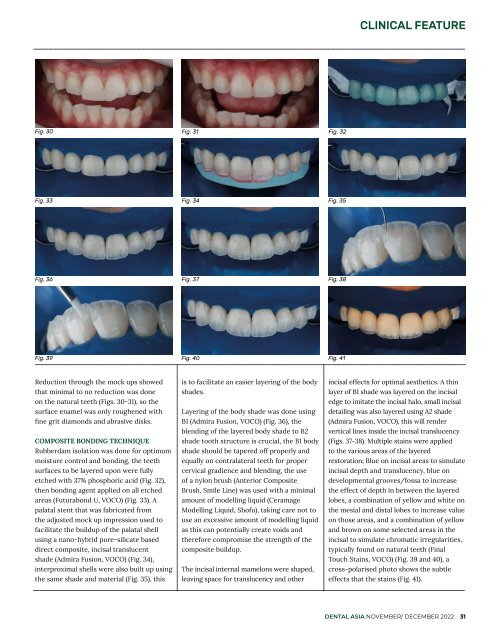Dental Asia November/December 2022
For more than two decades, Dental Asia is the premium journal in linking dental innovators and manufacturers to its rightful audience. We devote ourselves in showcasing the latest dental technology and share evidence-based clinical philosophies to serve as an educational platform to dental professionals. Our combined portfolio of print and digital media also allows us to reach a wider market and secure our position as the leading dental media in the Asia Pacific region while facilitating global interactions among our readers.
For more than two decades, Dental Asia is the premium journal in linking dental innovators and manufacturers to its rightful audience. We devote ourselves in showcasing the latest dental technology and share evidence-based clinical philosophies to serve as an educational platform to dental professionals. Our combined portfolio of print and digital media also allows us to reach a wider market and secure our position as the leading dental media in the Asia Pacific region while facilitating global interactions among our readers.
You also want an ePaper? Increase the reach of your titles
YUMPU automatically turns print PDFs into web optimized ePapers that Google loves.
CLINICAL FEATURE<br />
Fig. 30 Fig. 31<br />
Fig. 32<br />
Fig. 33<br />
Fig. 34<br />
Fig. 35<br />
Fig. 36<br />
Fig. 37<br />
Fig. 38<br />
Fig. 39 Fig. 40 Fig. 41<br />
Reduction through the mock ups showed<br />
that minimal to no reduction was done<br />
on the natural teeth (Figs. 30-31), so the<br />
surface enamel was only roughened with<br />
fine grit diamonds and abrasive disks.<br />
COMPOSITE BONDING TECHNIQUE<br />
Rubberdam isolation was done for optimum<br />
moisture control and bonding, the teeth<br />
surfaces to be layered upon were fully<br />
etched with 37% phosphoric acid (Fig. 32),<br />
then bonding agent applied on all etched<br />
areas (Futurabond U, VOCO) (Fig. 33). A<br />
palatal stent that was fabricated from<br />
the adjusted mock up impression used to<br />
facilitate the buildup of the palatal shell<br />
using a nano-hybrid pure-silicate based<br />
direct composite, incisal translucent<br />
shade (Admira Fusion, VOCO) (Fig. 34),<br />
interproximal shells were also built up using<br />
the same shade and material (Fig. 35), this<br />
is to facilitate an easier layering of the body<br />
shades.<br />
Layering of the body shade was done using<br />
B1 (Admira Fusion, VOCO) (Fig. 36), the<br />
blending of the layered body shade to B2<br />
shade tooth structure is crucial, the B1 body<br />
shade should be tapered off properly and<br />
equally on contralateral teeth for proper<br />
cervical gradience and blending, the use<br />
of a nylon brush (Anterior Composite<br />
Brush, Smile Line) was used with a minimal<br />
amount of modelling liquid (Ceramage<br />
Modelling Liquid, Shofu), taking care not to<br />
use an excessive amount of modelling liquid<br />
as this can potentially create voids and<br />
therefore compromise the strength of the<br />
composite buildup.<br />
The incisal internal mamelons were shaped,<br />
leaving space for translucency and other<br />
incisal effects for optimal aesthetics. A thin<br />
layer of B1 shade was layered on the incisal<br />
edge to imitate the incisal halo, small incisal<br />
detailing was also layered using A2 shade<br />
(Admira Fusion, VOCO), this will render<br />
vertical lines inside the incisal translucency<br />
(Figs. 37-38). Multiple stains were applied<br />
to the various areas of the layered<br />
restoration; Blue on incisal areas to simulate<br />
incisal depth and translucency, blue on<br />
developmental grooves/fossa to increase<br />
the effect of depth in between the layered<br />
lobes, a combination of yellow and white on<br />
the mesial and distal lobes to increase value<br />
on those areas, and a combination of yellow<br />
and brown on some selected areas in the<br />
incisal to simulate chromatic irregularities,<br />
typically found on natural teeth (Final<br />
Touch Stains, VOCO) (Fig. 39 and 40), a<br />
cross-polarised photo shows the subtle<br />
effects that the stains (Fig. 41).<br />
DENTAL ASIA NOVEMBER/ DECEMBER <strong>2022</strong> 31


















